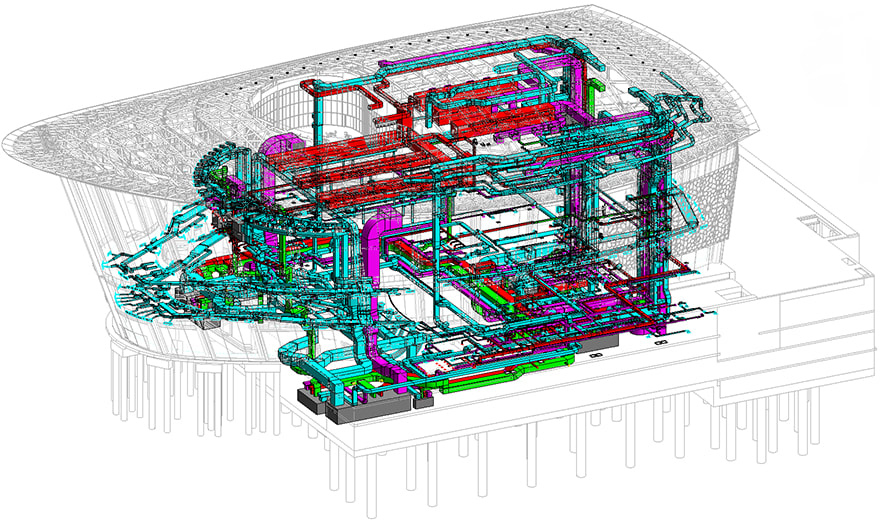- Client: Emaar Properties
- Lead Contractor: Consolidated Construction Company, Lead designer: Atkins
- BIM Tools: Revit, Navisworks, Grasshopper, Rhino, others
Designed by Atkins this 2,000-seat, multi-format theatre will become a focal point in the Opera District in the heart of Downtown Dubai, a new arts and lifestyle destination.
Its form is rooted in Dubai’s maritime history with a bow-shaped transparent glass facade that was inspired by the Arabian dhow. This bow contains the theatre’s main stage, orchestra and seating areas, while a rooftop sky garden and restaurant provide scenic views over Opera Plaza and Mohammed Bin Rashid Boulevard.
The compact building space, dense steel structure and large number of moving elements inside (including floors, walls and ceilings designed to transform into different modes to host opera, theatre, concert and flat-floor exhibitions) required extreme attention to detail to ensure the feasibility of MEP service routes.
The use of BIM was critical to coordination and evolved from a fairly rudimentary implementation during early design stages, to a fully integrated multi-disciplinary model, used to coordinate construction.
Richard Smith, technical director at Atkins explains to BIM+: “When we started the design, in 2012, BIM was not widely used in the Middle East. We drove the decision to implement it across the design consultant team to improve coordination and help deliver the project in the tight design and construction period.”
With elements such as BIM Execution Plans and BIM Protocols not yet in common use, a manager at Atkins was instead tasked with maintaining the centralised Revit model and planning and defining all requirements.
Many surfaces in the building are double curved and a combination of Grasshopper and Rhino were used create the complex 3D geometries, with Revit used for coordination. The facade and roof, designed by Stuttgart-based Werner Sobek Architects, were a particular challenge. The glass cladding system includes 2,920 panels, half of which are unique.

The use of BIM evolved from a fairly rudimentary implementation during early design stages
The centralised Revit model was used as the basis for various other 3D and analytical models for lighting, structures and thermal performance.
Smith comments: “The client wanted the space to ‘shine like a lantern’ so our lighting consultant, Neolight, used the master BIM model to inform its specialist lighting software and model illumination levels in the space.”
The consultancy division of the IES software company used it to develop a thermal model of the complex curving foyer space that wraps around the front and sides of the building and experiences a varying cooling demand due to the changing solar gains distribution through the day.
When the client saw the benefits of using BIM, it mandated the software’s use for the remainder of the project, from when the design was handed over to the main contractor. This decision was also informed by a new BIM mandate, introduced by the Dubai government in 2013, requiring the use of BIM on all buildings with areas larger than 300,000 sq ft, or above 40 floors high.
Atkins’ original Revit model was used as the basis of all subsequent 3D design work, produced by CCC, M&E services contractor BK Gulf, steel structure specialist Eversendai Engineering and cladding and roof specialist Arabian Profile
Although the use of BIM did not deliver overall time savings for the design of the project, it helped resolve hundreds of coordination issues, which massively reduced the amount of remedial work on site and reduced waste, says Smith.
“I cannot see how we could have completed this job without BIM, the complex holes through the sloping walls would have been very difficult to identify if they were only detailed in 2D,” says Smith. “When I said this to the theatre consultant he told me that previously his team would have been on site full time sorting out issues as the scheme was built, but BIM allowed us to offset and mitigate a lot of that,” he concludes.
When we started the design, in 2012, BIM was not widely used in the Middle East. We drove the decision to implement it across the design consultant team to improve coordination and help deliver the project in the tight design and construction period.– Richard Smith, Atkins











